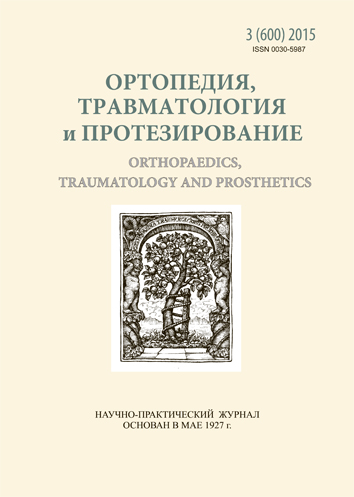Age features of mineral density and quality of bone tissue in men
DOI:
https://doi.org/10.15674/0030-59872015365-70Keywords:
quality of trabecular bone tissue, bone mineral density, menAbstract
Objective: To evaluate the quality score (TBS) and bone mineral density (BMD) in practically healthy Ukrainian men.
Methods: There were examined 191 healthy men aged from 30 to 89 years (average age 57,4 ± 13,7, average growth (174,4 ± 6,8) cm, and average body weight 76.6 ± 9,3 kg). Depending on the age all surveyed men were divided into six groups by decades: 30–39 (19 persons), 40–49 (34), 50–59 (48), 60–69 (48), 70–79 (34), 80–89 (8). By means of dual energy X-ray densitometry method («Prodigy, GE Lunar», Madison, USA) we measured BTMD at the lumbar spine (LI-LIV) level, femoral neck, entire skeleton and ultradistal part of the forearm. Indicator TBS for the lumbar spine we determined using the procedure TBS iNsight («Med-Imaps», Pessac, France).
Results: significant decline of TBS LI–LIV begins in men since 60 years and amount 1,152 ± 0,18 vs 1,263 ± 0,12 in men 30–39 years of age group (p = 0,01), and 1,273 ± 0, 12 in group of 40–49 years (p <0,001). Also in men we have identified decreasing with age BMD of the femoral neck (F = 5,38; p <0,001), the entire skeleton (F = 7,75; p < 0,001) and ultradistal part of forearm bones (F = 3,34; p = 0.007). Reliable correlation TBS index with age was found (r = –0,25; p = 0,0007). However the relationship between TBS and BMD indeces on the lumbar spine and femoral neck was not revealed.
Conclusions: age has a significant impact on the variability of TBS index and its structural and functional state. According to results of dual energy X-ray absorptiometry reliable decreasing of BMD in men with age one may observe at the level of the femoral neck, entire skeleton and bones of the forearm.
References
- Nasonov E. L. Nonsteroidal anti-inflammatory drugs (the medical uses) / E. L. Nasonov — М., 2000. — 262 p.
- Parfenov V. A. Diagnosis and treatment of back pain / V. A. Parfenov // Russian Medical Journal. — 2004. — № 12 (2). — P. 115–118.
- Penner V. A. Back pain in osteoporosis: diagnosis and treatment / V. A. Penner, O. I. Nishkumay, O. V. Skorobogatov // Ukrainian Rheumatological Journal. — 2013. — № 53 (3). — Р. 41–44.
- Povoroznyuk V. V. Pain in osteoporosis and correction methods / V. V. Povoroznyuk, N. V. Grigorieva // Pain. Joints. Spine. — 2011. — № 1. — P. 41–45.
- Povoroznyuk V. V. Low back pain / V. V. Povoroznyuk // Medix. Anti-Eydzhing. — 2009. — № 2 (8). — P. 54–60.
- Povoroznyuk V. V. Efficacy Ranseleks in management in patients of low back pain of different age with osteochondrosis / V. V. Povoroznyuk, Y. A. Kreslov // Art of Treatment. — 2006. — № 8. — P. 64–67.
- DePalma M., Gasper J. Cellular supplementation technologies for painful spine disorders / M. DePalma, J. Gasper // PmR. — 2015. — Vol. 7 (4 Suppl.). — Р. 19–25, doi: 10.1016/j.pmrj.2015.01.022.
- Deyo R. A. Back pain prevalence and visit rates: estimates from U.S. national surveys, 2002 / R. A. Deyo, S. K. Mirza, B. I. Martin // Spine. — 2006. — Vol. 31 (23). — Р. 2724–2727.
- Kent P. M. The epidemiology of low back pain in primary care / P. M. Kent, J. L. Keating // Chiropr Osteopat. — 2005. — Vol. 13. — Р. 13–17.
- Louw Q. A. The prevalence of low back pain in Africa: a sy-stematic review / Q. A. Louw, L. D. Morris, K. Grimmer-Somers // BMC Musculoskelet Disord. — 2007. — Vol. 8. — Article 105.
- Merskey H. Classification of chronic pain. Descriptions of chronic pain syndromes and definitions of pain terms / Eds. H. Merskey, N. Bogduk. — 2nd ed. — Seattle: IASP Press, 1994. — 238 p.
- Osteoporotic pain [on-line source] / S. Orita, S. Ohtori, G. Inoue, K. Takahashi // Osteoporosis. — 2012. — Р. 541–554. — Access mode: http://cdn.intechopen.com/pdfs-wm/29560.pdf/.
- Prevalence of low back pain in Greek public office workers / P. Spyropoulos, G. Papathanasiou, G. Georgoudis [et al.] // Pain Physician. — 2007. — 10. — Р. 651–660.
Downloads
How to Cite
Issue
Section
License
Copyright (c) 2015 Vladyslav Povorozniuk, Anna Mysiienko, Nataliya Dzerovych

This work is licensed under a Creative Commons Attribution 4.0 International License.
The authors retain the right of authorship of their manuscript and pass the journal the right of the first publication of this article, which automatically become available from the date of publication under the terms of Creative Commons Attribution License, which allows others to freely distribute the published manuscript with mandatory linking to authors of the original research and the first publication of this one in this journal.
Authors have the right to enter into a separate supplemental agreement on the additional non-exclusive distribution of manuscript in the form in which it was published by the journal (i.e. to put work in electronic storage of an institution or publish as a part of the book) while maintaining the reference to the first publication of the manuscript in this journal.
The editorial policy of the journal allows authors and encourages manuscript accommodation online (i.e. in storage of an institution or on the personal websites) as before submission of the manuscript to the editorial office, and during its editorial processing because it contributes to productive scientific discussion and positively affects the efficiency and dynamics of the published manuscript citation (see The Effect of Open Access).














